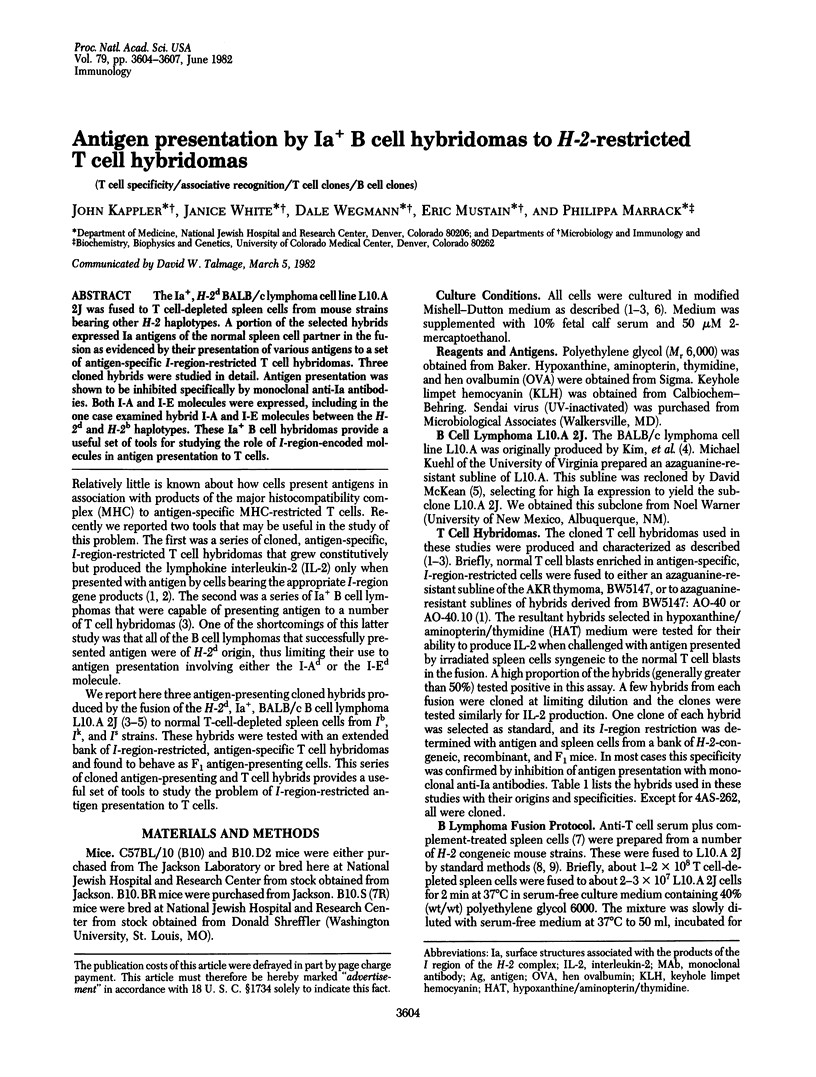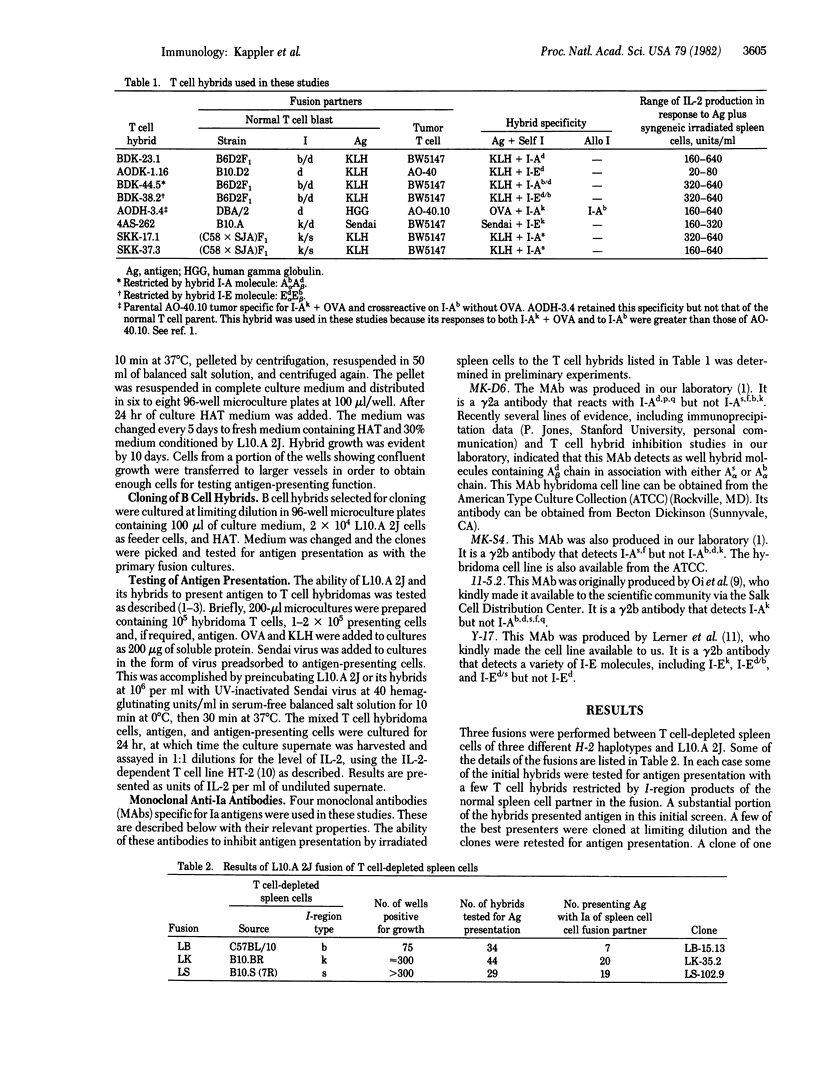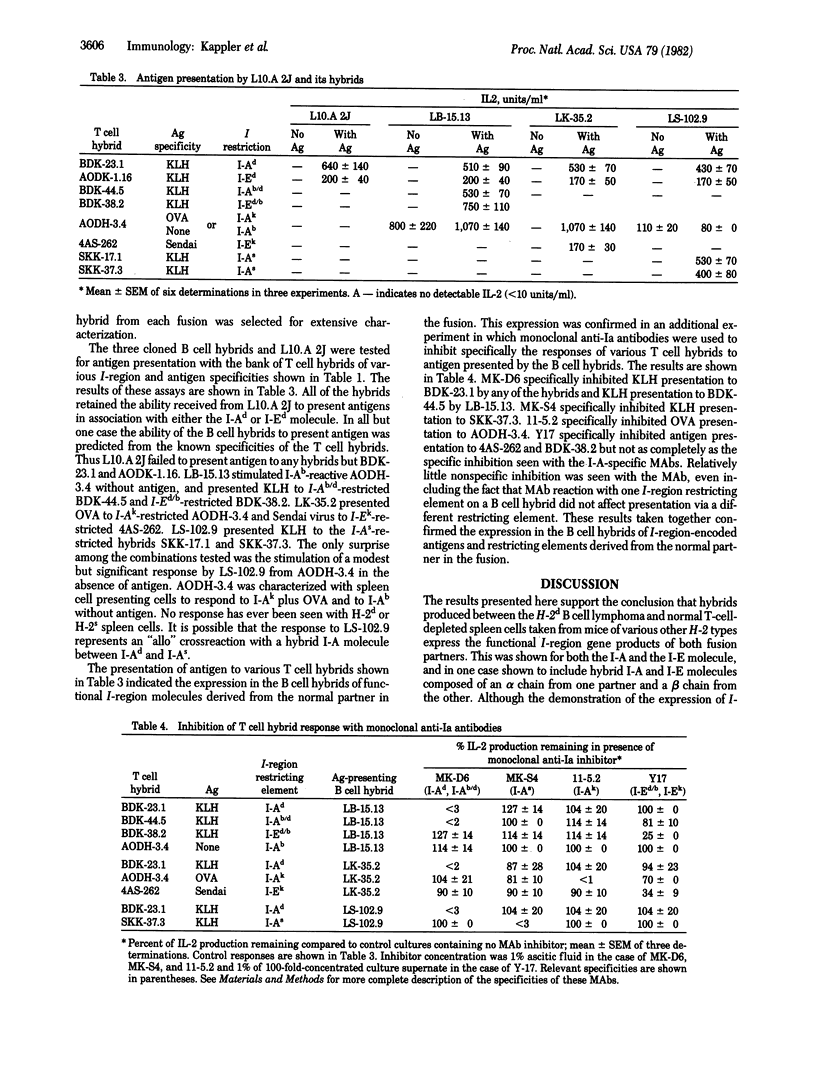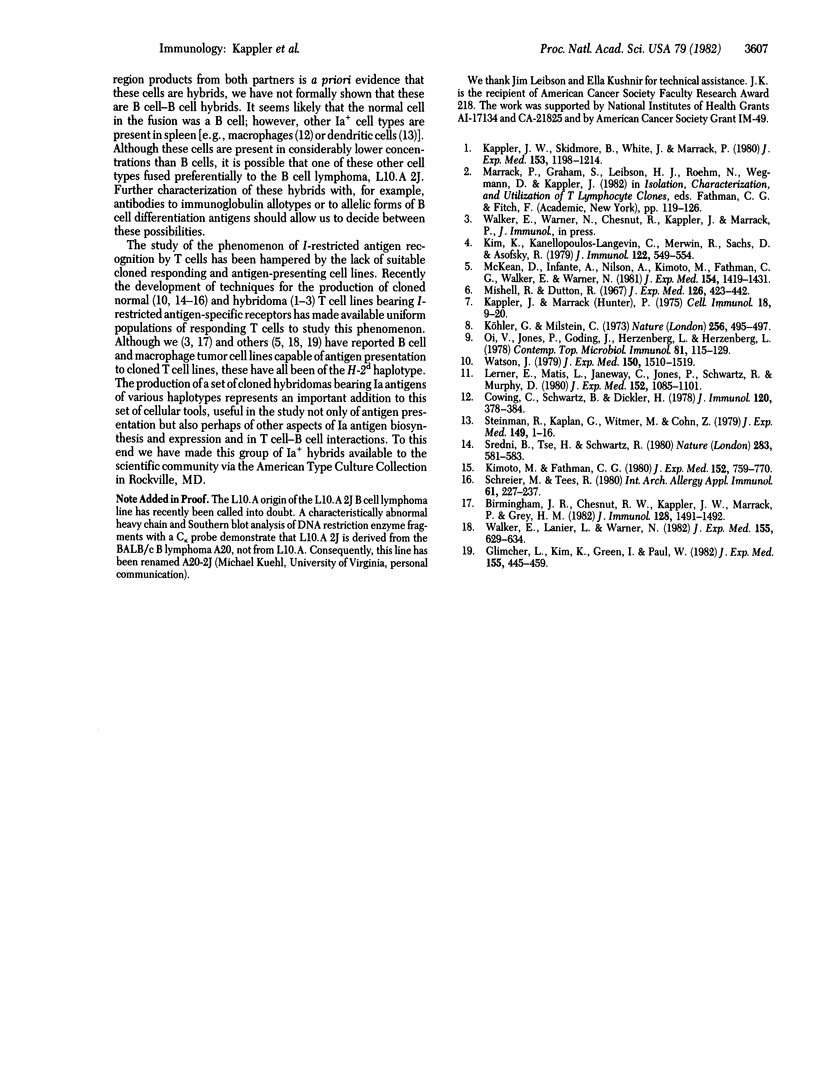Abstract
The Ia+, H-2d BALB/c lymphoma cell line L10.A 2J was fused to T cell-depleted spleen cells from mouse strains bearing other H-2 haplotypes. A portion of the selected hybrids expressed Ia antigens of the normal spleen cell partner in the fusion as evidenced by their presentation of various antigens to a set of antigen-specific I-region-restricted T cell hybridomas. Three cloned hybrids were studied in detail. Antigen presentation was shown to be inhibited specifically by monoclonal anti-Ia antibodies. Both I-A and I-E molecules were expressed, including in the one case examined hybrid I-A and I-E molecules between the H-2d and H-2b haplotypes. These Ia+ B cell hybridomas provide a useful set of tools for studying the role of I-region-encoded molecules in antigen presentation to T cells.
Full text
PDF



Selected References
These references are in PubMed. This may not be the complete list of references from this article.
- Birmingham J. R., Chesnut R. W., Kappler J. W., Marrack P., Kubo R., Grey H. M. Antigen presentation to T cell hybridomas by a macrophage cell line: an inducible function. J Immunol. 1982 Mar;128(3):1491–1492. [PubMed] [Google Scholar]
- Cowing C., Schwartz B. D., Dickler H. B. Macrophage Ia antigens. I. macrophage populations differ in their expression of Ia antigens. J Immunol. 1978 Feb;120(2):378–384. [PubMed] [Google Scholar]
- Glimcher L. H., Kim K. J., Green I., Paul W. E. Ia antigen-bearing B cell tumor lines can present protein antigen and alloantigen in a major histocompatibility complex-restricted fashion to antigen-reactive T cells. J Exp Med. 1982 Feb 1;155(2):445–459. doi: 10.1084/jem.155.2.445. [DOI] [PMC free article] [PubMed] [Google Scholar]
- Kappler J. W., Marrack P. C. Functional heterogeneity among the T-derived lymphocytes of the mouse. III. Helper and suppressor T-cells activated by concanavalin A. Cell Immunol. 1975 Jul;18(1):9–20. doi: 10.1016/0008-8749(75)90031-3. [DOI] [PubMed] [Google Scholar]
- Kappler J. W., Skidmore B., White J., Marrack P. Antigen-inducible, H-2-restricted, interleukin-2-producing T cell hybridomas. Lack of independent antigen and H-2 recognition. J Exp Med. 1981 May 1;153(5):1198–1214. doi: 10.1084/jem.153.5.1198. [DOI] [PMC free article] [PubMed] [Google Scholar]
- Kim K. J., Kanellopoulos-Langevin C., Merwin R. M., Sachs D. H., Asofsky R. Establishment and characterization of BALB/c lymphoma lines with B cell properties. J Immunol. 1979 Feb;122(2):549–554. [PubMed] [Google Scholar]
- Kimoto M., Fathman C. G. Antigen-reactive T cell clones. I. Transcomplementing hybrid I-A-region gene products function effectively in antigen presentation. J Exp Med. 1980 Oct 1;152(4):759–770. doi: 10.1084/jem.152.4.759. [DOI] [PMC free article] [PubMed] [Google Scholar]
- Köhler G., Milstein C. Continuous cultures of fused cells secreting antibody of predefined specificity. Nature. 1975 Aug 7;256(5517):495–497. doi: 10.1038/256495a0. [DOI] [PubMed] [Google Scholar]
- Lerner E. A., Matis L. A., Janeway C. A., Jr, Jones P. P., Schwartz R. H., Murphy D. B. Monoclonal antibody against an Ir gene product? J Exp Med. 1980 Oct 1;152(4):1085–1101. doi: 10.1084/jem.152.4.1085. [DOI] [PMC free article] [PubMed] [Google Scholar]
- McKean D. J., Infante A. J., Nilson A., Kimoto M., Fathman C. G., Walker E., Warner N. Major histocompatibility complex-restricted antigen presentation to antigen-reactive T cells by B lymphocyte tumor cells. J Exp Med. 1981 Nov 1;154(5):1419–1431. doi: 10.1084/jem.154.5.1419. [DOI] [PMC free article] [PubMed] [Google Scholar]
- Mishell R. I., Dutton R. W. Immunization of dissociated spleen cell cultures from normal mice. J Exp Med. 1967 Sep 1;126(3):423–442. doi: 10.1084/jem.126.3.423. [DOI] [PMC free article] [PubMed] [Google Scholar]
- Oi V. T., Jones P. P., Goding J. W., Herzenberg L. A., Herzenberg L. A. Properties of monoclonal antibodies to mouse Ig allotypes, H-2, and Ia antigens. Curr Top Microbiol Immunol. 1978;81:115–120. doi: 10.1007/978-3-642-67448-8_18. [DOI] [PubMed] [Google Scholar]
- Schreier M. H., Tees R. Clonal induction of helper T cells: conversion of specific signals into nonspecific signals. Int Arch Allergy Appl Immunol. 1980;61(2):227–237. doi: 10.1159/000232437. [DOI] [PubMed] [Google Scholar]
- Sredni B., Tse H. Y., Schwartz R. H. Direct cloning and extended culture of antigen-specific MHC-restricted, proliferating T lymphocytes. Nature. 1980 Feb 7;283(5747):581–583. doi: 10.1038/283581a0. [DOI] [PubMed] [Google Scholar]
- Steinman R. M., Kaplan G., Witmer M. D., Cohn Z. A. Identification of a novel cell type in peripheral lymphoid organs of mice. V. Purification of spleen dendritic cells, new surface markers, and maintenance in vitro. J Exp Med. 1979 Jan 1;149(1):1–16. doi: 10.1084/jem.149.1.1. [DOI] [PMC free article] [PubMed] [Google Scholar]
- Walker E. B., Lanier L. L., Warner N. L. Concomitant induction of the cell surface expression of Ia determinants and accessory cell function by a murine macrophage tumor cell line. J Exp Med. 1982 Feb 1;155(2):629–634. doi: 10.1084/jem.155.2.629. [DOI] [PMC free article] [PubMed] [Google Scholar]
- Watson J. Continuous proliferation of murine antigen-specific helper T lymphocytes in culture. J Exp Med. 1979 Dec 1;150(6):1510–1519. doi: 10.1084/jem.150.6.1510. [DOI] [PMC free article] [PubMed] [Google Scholar]


